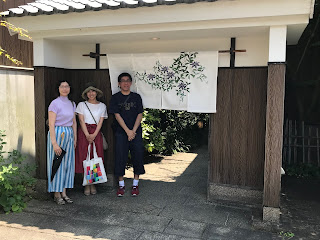 From the modern history of wartime and nuclear weapons, we sought refuge in the ancient Hiroshima castle and the Shukkein gardens.
From the modern history of wartime and nuclear weapons, we sought refuge in the ancient Hiroshima castle and the Shukkein gardens. It is amazing to me how an ancient castle can be surrounded by such a bustling city and such modern city buildings. The juxtaposition of old and new is striking but is quite a usual occurrence in Japan.

 I was interested in the small windows in the outside of this castle. As you can see from the photos they were different shapes. There were triangles, squares and rectangles. From inside you could see that they pointed down toward the moat and the wall so that intruders could be attacked through the tiny windows.
I was interested in the small windows in the outside of this castle. As you can see from the photos they were different shapes. There were triangles, squares and rectangles. From inside you could see that they pointed down toward the moat and the wall so that intruders could be attacked through the tiny windows.

Here is the Taiko (drum) that was used in the tower to alert the community. (This one's for you Ms. Wang and Ms. Hsu)
 Here is the main castle building. The birds circling around were enormous. Do you think they are hawks, vultures, or eagles? We needed some more fifth grade bird experts to help us out.
Here is the main castle building. The birds circling around were enormous. Do you think they are hawks, vultures, or eagles? We needed some more fifth grade bird experts to help us out.We climbed up many stories inside the main castle building which is now a museum filled with the history of the Samurai.


We each took a turn dressing as a Samurai.


The view from the top was amazing.
The Shukkein Gardens are gardens are a beautiful quiet refuge in the middle of the city. While we were there, there was a photo shoot going on with a couple in their wedding kimono. Maybe Ms. Gannon should have arranged for this as well as part of her honeymoon trip.

 Balance is very important in Japanese design and this garden balances the water and land by incorporating 11 different islands into the park. It is meant to represent a shrunken version of different landscapes of China. There are small rice paddies, small mountains, small waterfalls, small beaches, and many many bridges.
Balance is very important in Japanese design and this garden balances the water and land by incorporating 11 different islands into the park. It is meant to represent a shrunken version of different landscapes of China. There are small rice paddies, small mountains, small waterfalls, small beaches, and many many bridges. 



After a lovely walk all around the different landscapes, we were ready for some refreshment. I chose Matcha cheesecake that was sooooo delicious. Mrs. Ohguchi had traditional tea and sweets (bean paste) and Toshi chose blue shaved ice with fruit and ice cream! Good stuff.







































